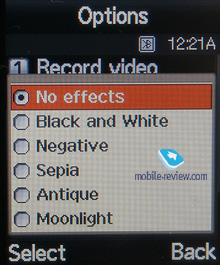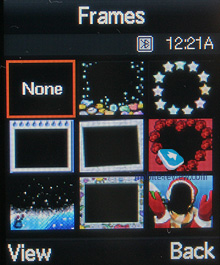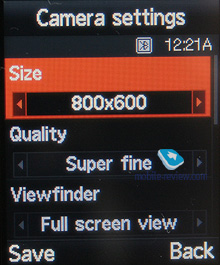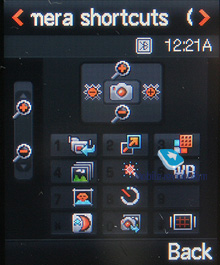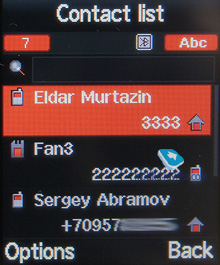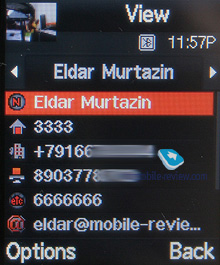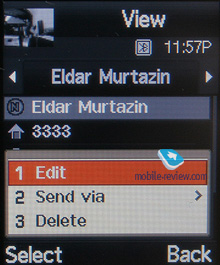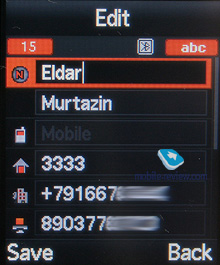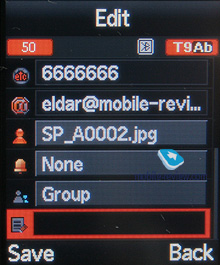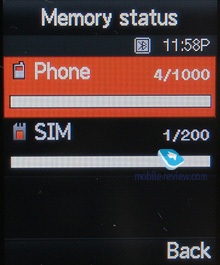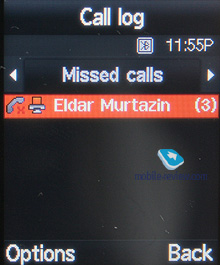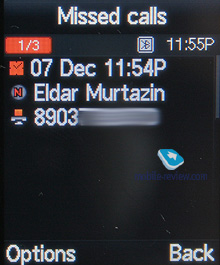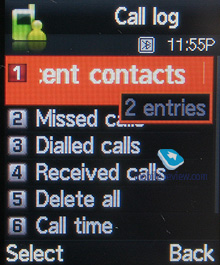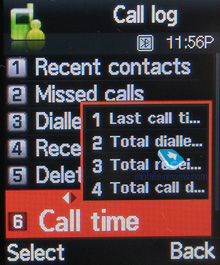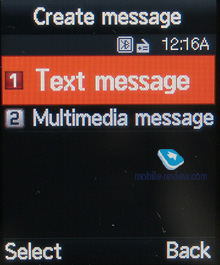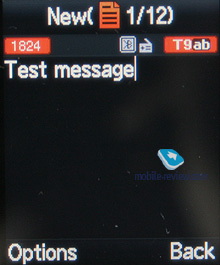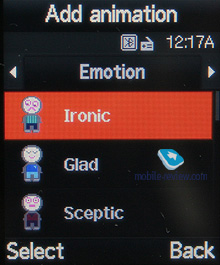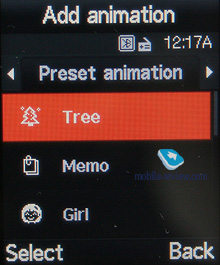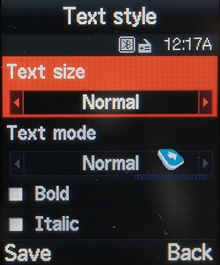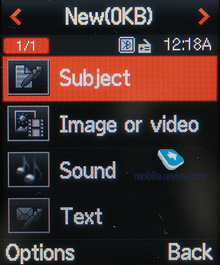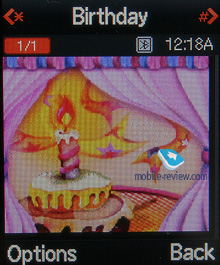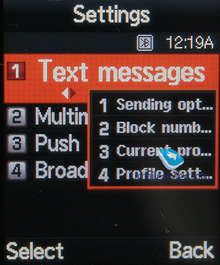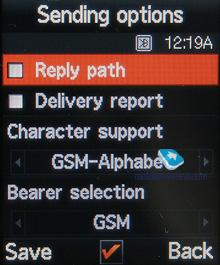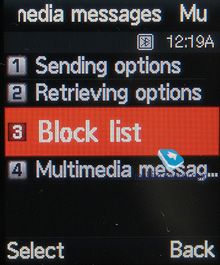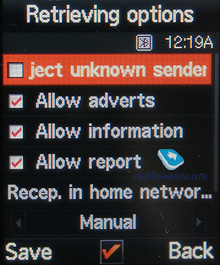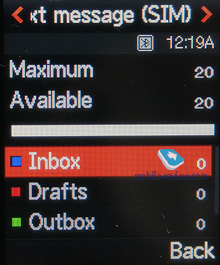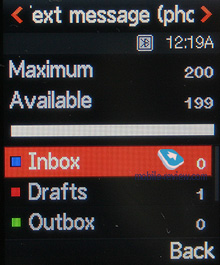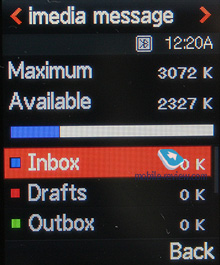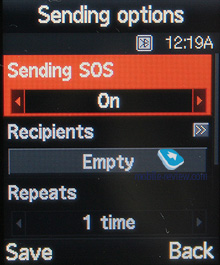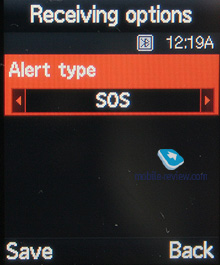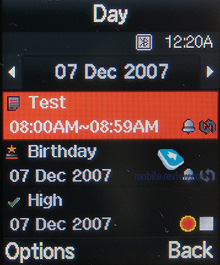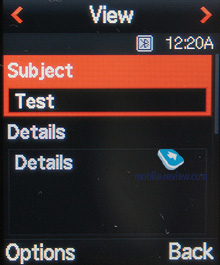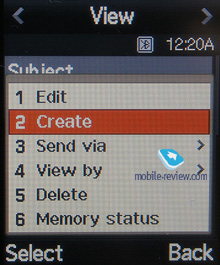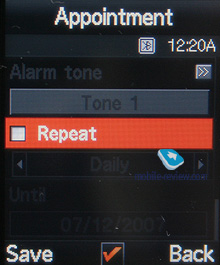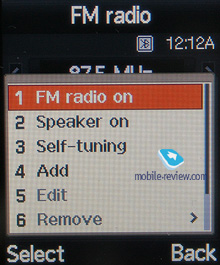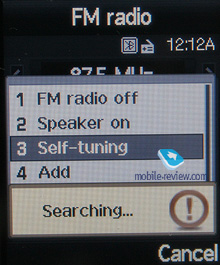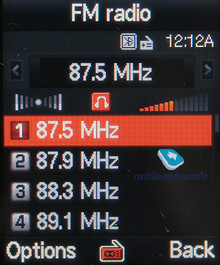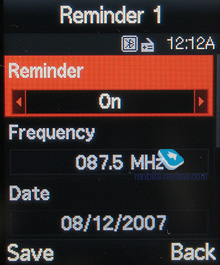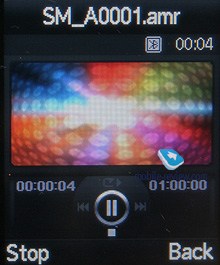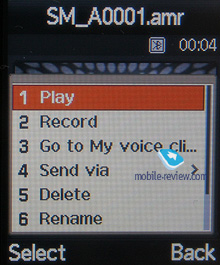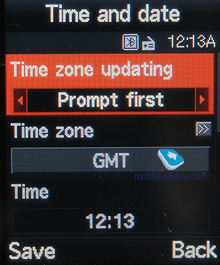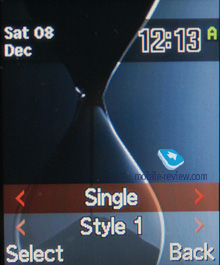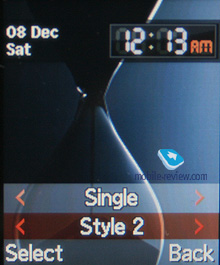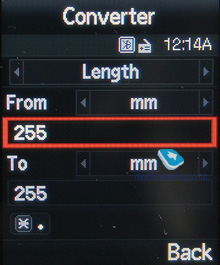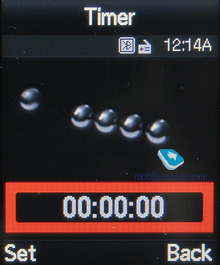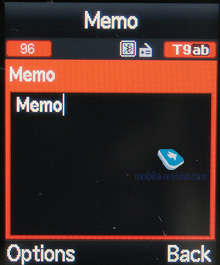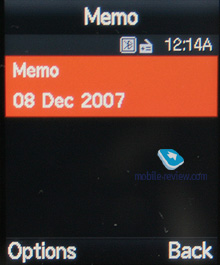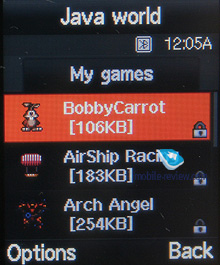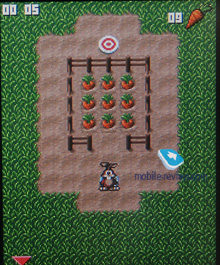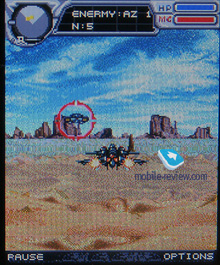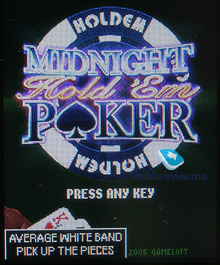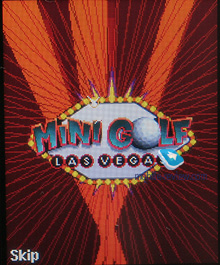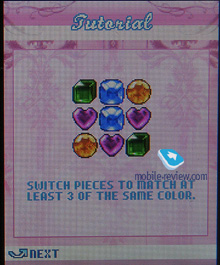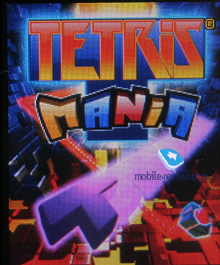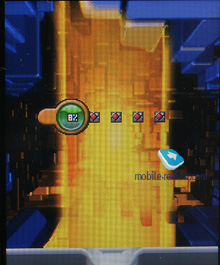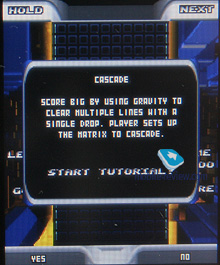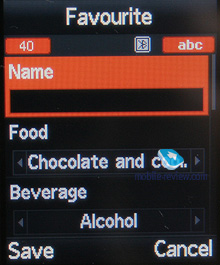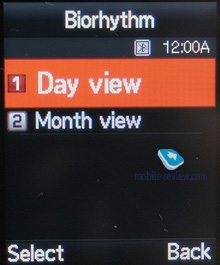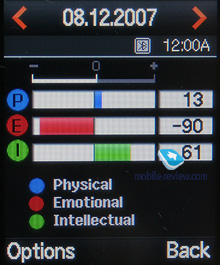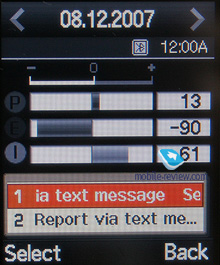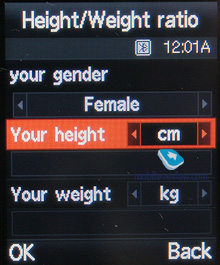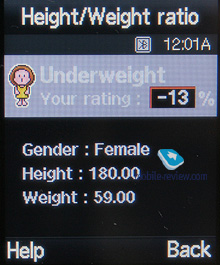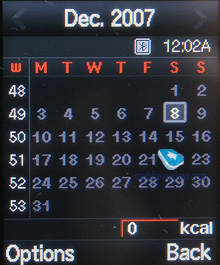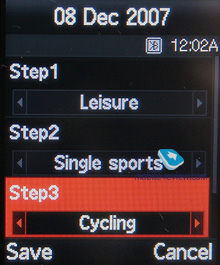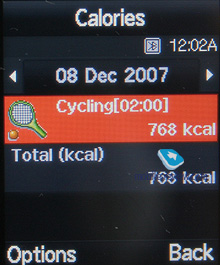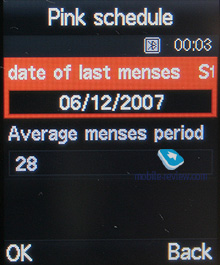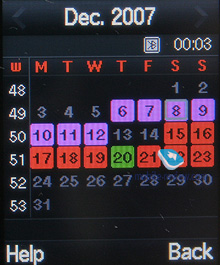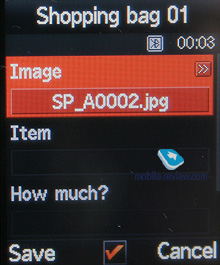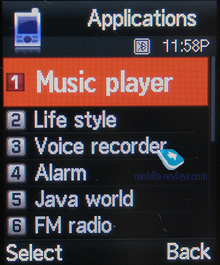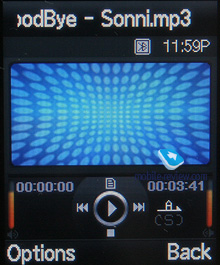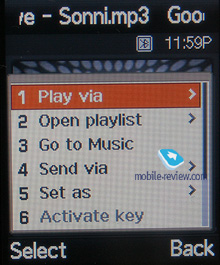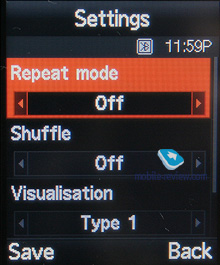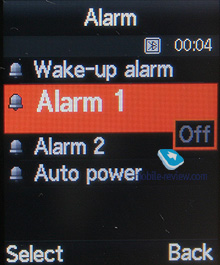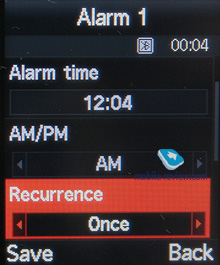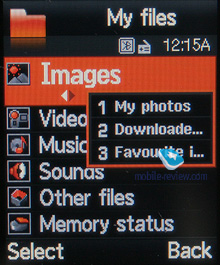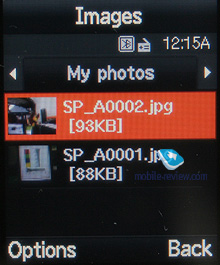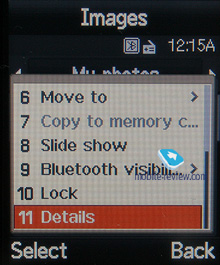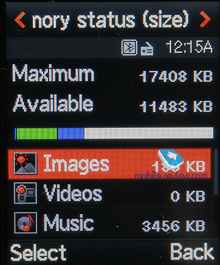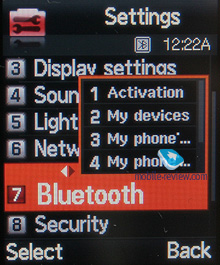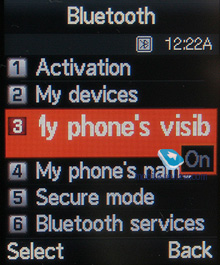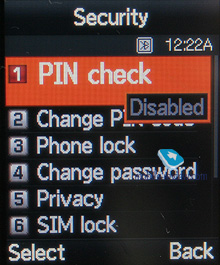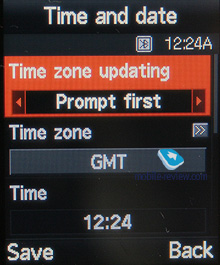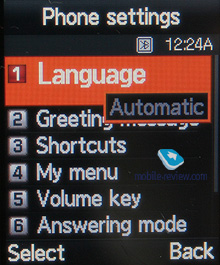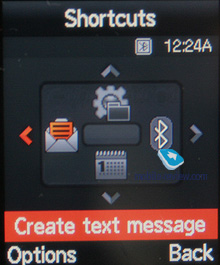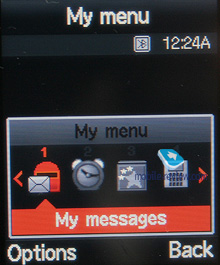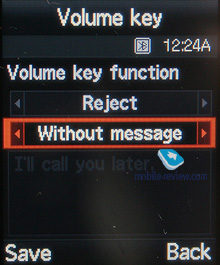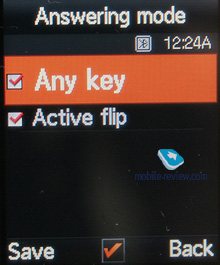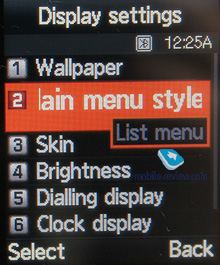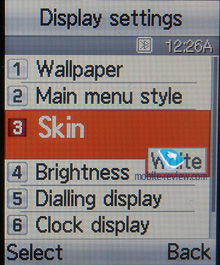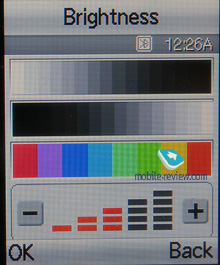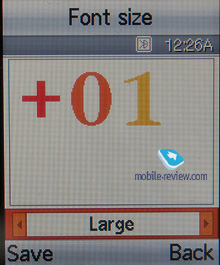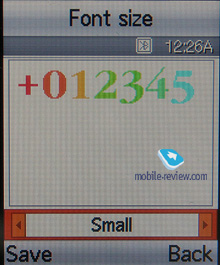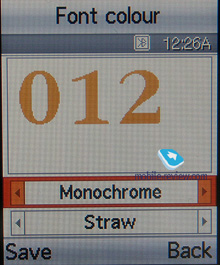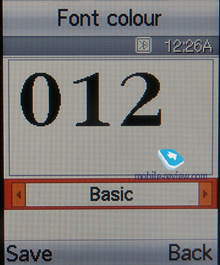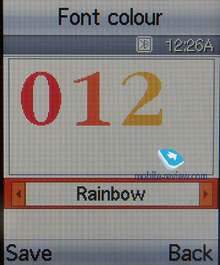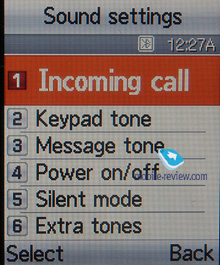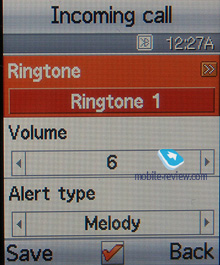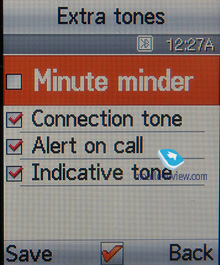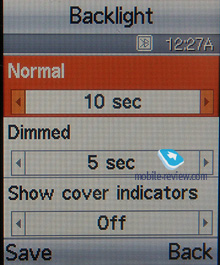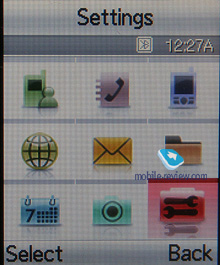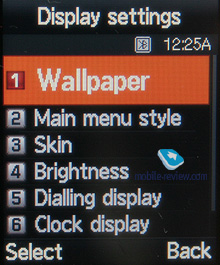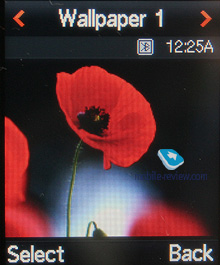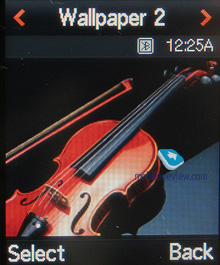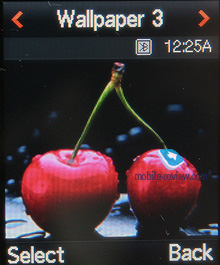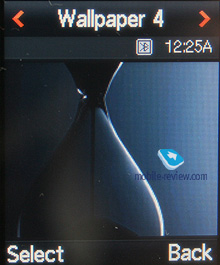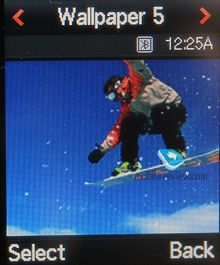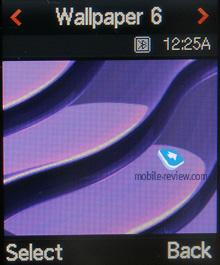Review of GSM-handset Samsung L320
Live photos of Samsung L320
Table of contents:
- Positioning
- Design, size, controls
- Display
- Keypad
- Battery
- USB, Bluetooth, connectivity
- Memory, Memory Cards
- Performance
- Camera
- Menu
- Phonebook
- Call log
- Messaging
- Organizer
- Applications
- WAP
- MP3-player
- Settings
- Impressions
Sales package:
- Handset
- Charger
- Battery
- USB data cable
- Wired stereo-headset
- Wrist strap
- ser Guide
Positioning
While the Samsung L320 is at the top of the La’Fleur 2 range, it doesn’t automatically mean there are no L-branded models with higher indexes. At the MWC in Barcelona the maker also rolled out the sliding Samsung L700, which is the senior offering in family as of today. This slight confusion with indexes is entirely due to the way they have put together the line-up for women – while these devices are based on the same concept, this whole line-up hinges on the pricing policy. Indeed, if you look at the La’Fleur range you will see that its members don’t differ that much as far as their price tags go. Had they thrown the L700 or some other solutions in, it would have harmed the focus on a certain price bracket. On top of that, inflating the collection up to four and more offerings isn’t the best thing to do in that they wouldn’t have the same focus, and would be very a true challenge to promote. On a side note, the “L” index doesn’t necessarily mean every phone bearing it is aimed solely at women; in fact, there may be solutions that are positioned in a different way.

Another thing of note about the Samsung L320 is where it’s drawing inspiration from – the Samsung E570 (Aqua), the most popular feminine phone from Samsung that was included in the original La’Fleur collection. It caught many eyes thanks to its quirky rounded shapes, a vertically-arranged display and a wide selection of available trims. Its sales never knew major shake-ups and remained stable over the E570’s debut year on the market, so it would’ve been utterly unwise of Samsung to forgo a goldmine like this, and that’s how the L320 came along – retaining all the same ideas, but coming in a slightly different guise. While it does adopt some design cues from the E570, it still has an own distinctive style and is not a copy cat of its predecessor design-wise.



Back to the table of contents >>>
Design, size, controls
For now the L320 will come in only one color scheme – black glossy casing with a violet insert (Viola Black), but we will see more trims down the road, just like it was with the Samsung E570. It doesn’t take a rocket scientist to figure out that the L320 will definitely come in red, as well as blue and emerald; on the whole, the pool of available colors will total seven or even more options. This strategy, when more colors are released one after another is a part of the maker’s plan, for it allows increasing the given handset’s life span.


The L320 measures in at 89x45.5x23.5 mm and tips our scales at 100 grams –not quite the skinniest offering we have seen, but it is not gigantic either; size-wise it is just an average phone that happens to have its edges and corners rounded out, thus being very palm-friendly. The L320 is a snap to open single-handedly, thanks to the dent placed between the halves.






The rear plate houses a fancy pattern that blends with the casing, although it is easy to spot in bright light. In some ways, it adds a couple of points to the L320’s charm. The phone is by no means gaudy or overly flashy – on the contrary, it is quite unfussy for a feminine device. The violet insert goes well with the blue backlight of the outer display (it can house up to two text lines, which is quite enough for your daily needs, plus it shows missed calls, messages and currently playing track).

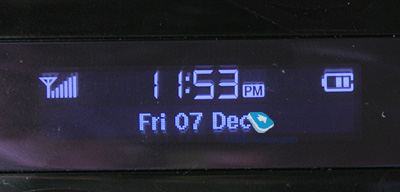
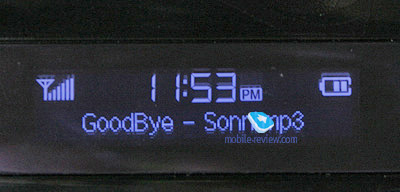
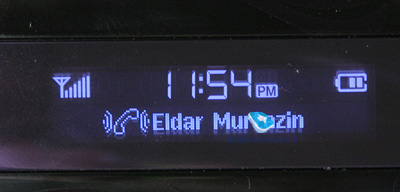

The left-hand side sports the volume rocker, while the opposite spine plays host to the lanyard eyelet, charger socket and microSD memory expansion slot. All jacks and sockets are covered by plastic flaps linked to the casing.
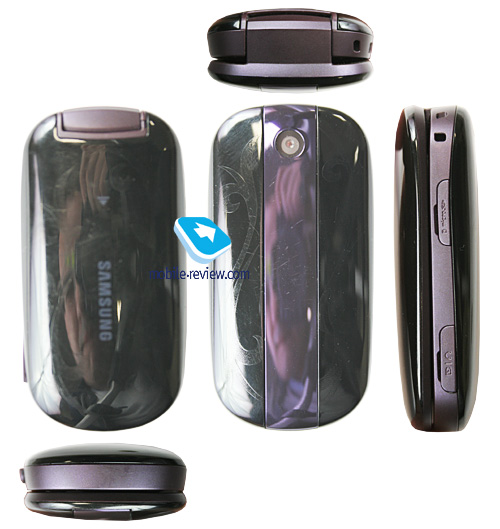
Back to the table of contents >>>
Display
The internal display sports a diagonal of 1.9 inches and a resolution of 176x220 pixels (TFT, 262K). Resolution-wise, it belongs to the previous generation and is obviously behind the competition. While its picture is quite good (bright and crisp), it still falls short of other offerings featuring bigger displays with better resolutions. The screen can accommodate up to 7 text and 3 service lines. It remains readable in the sun, although it gets washed out a little.
Back to the table of contents >>>
Keypad
The L320’s convex keys are made of plastic and offer a convenient layout coupled with overall softness. The keypad here is a treat to handle; it delivers a nice tactile feedback and gives us absolutely no reason to fault it for something. All buttons are lit in violet, matching the casing’s color scheme. Curiously, the functional keys are rubberized, making for an interesting combination with the plasticky number pad. The L320 packs in shortcuts to the player and camera applications.


Back to the table of contents >>>
Battery
The handset utilizes a 880 mAh Li-Ion battery, rated for 250 hours of standby and 2.5 hours of talk time. Within European networks the L320 lasted around 5 days with an hour of calls, and around 20 SMS total. At the same time, we could squeeze only around 3 days out of it in Moscow with the same usage mode. It takes the L320 around 1.5 hours to charge up. Unfortunately, there is no high-capacity cell available for this mode.


Battery time-wise, the Samsung L320 seems to be a decent performer that trumps the L310 hands down, offering up to twice as much of online time. This is one of those phones that just keep putting in hour after hour without asking for more juice.
Back to the table of contents >>>
USB, Bluetooth, connectivity
Bluetooth. The model supports various profiles, such as Headset, Handsfree, Serial Port, Dial Up Networking, File Transfer, Object Push, Basic Printing, A2DP. EDR-enabled Bluetooth 2.0 is onboard. Headset management doesn’t allow us to have any quibbles with it, everything is standard here.
USB-connection. In the menu you may select one of three modes: Media, Mass Storage, Samsung PC Studio. No Modem mode available with the L320, there is even no such option in PC Studio.
While in the USB Mass Storage mode, the L320 shows up on the desktop without requiring you to install any additional drivers, so right after plugging in it’s ready to work. Data connection speeds top out at 2000-2200 Kb/s.
You won’t be able to use the L320’s Bluetooth connectivity along with USB – it will require you to disable Bluetooth regardless of its status (connected and transferring data or not), which is very awkward.
When connected to a PC via USB, the L320 automatically recharges itself.
For GSM networks, the L320 comes with EDGE class 10 data.
Back to the table of contents >>>
Memory, Memory Cards
The phone ships with 17.5 Mb of onboard memory – this storage space, give or take, is available to the user right out of the box. The memory card (hot-swappable) is displayed as a separate section, so you can’t access both memory types at a time. The L320 also comes with a file manager, enabling you to copy files to/from the memory card. In our test the handset had no problems handling a 2 Gb microSD memory card, whereas a 4 Gb unit remained unidentified.
Back to the table of contents >>>
Performance
The L320’s performance is very typical for the previous generation of Samsung’s phones, although for a product of this type it is nothing out of the ordinary. New applications can be uploaded only over the air (Wap).

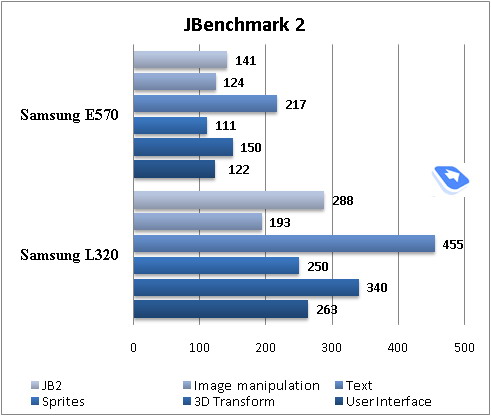

Back to the table of contents >>>
Camera
The handset comes equipped with a 2 Mpix CMOS camera (no auto-focus). It is quite average spec-wise – while its snaps look okay on the L320’s screen, they lose a big chunk of their quality when viewed on PC. The following resolution modes are supported:
- 1600x1200 pixels
- 1280x960 pixels
- 1024x768 pixels
- 800x600 pixels
- 640x480 pixels
- 320x240 pixels
- 176x220 pixels
- 176x144 pixels

There are also four quality settings (JPEG), as well as the night mode, white balance, shutter sound on/off options, self-timer (3, 5 and 10 seconds), and an array of effects (Black&White, Negative, Sepia, Antique, Moonlight). You can also opt to shoot a series of 6 or 15 images in a rapid succession (at an adjustable interval). Plus the L320 sports the mosaic mode and an assortment of frames for your snaps.
 |
 |
| (+) maximize, 1600õ1200, JPEG |
(+) maximize, 1600õ1200, JPEG |
 |
 |
| (+) maximize, 1600õ1200, JPEG |
(+) maximize, 1600õ1200, JPEG |
 |
 |
| (+) maximize, 1600õ1200, JPEG |
(+) maximize, 1600õ1200, JPEG |
 |
 |
| (+) maximize, 1600õ1200, JPEG |
(+) maximize, 1600õ1200, JPEG |
 |
 |
| (+) maximize, 1600õ1200, JPEG |
(+) maximize, 1600õ1200, JPEG |
 |
 |
| (+) maximize, 1600õ1200, JPEG |
(+) maximize, 1600õ1200, JPEG |
 |
 |
| (+) maximize, 1600õ1200, JPEG |
(+) maximize, 1600õ1200, JPEG |
Video can be recorded in one of the following resolutions: 176x144, and 128x96 pixels, on top of that you can enable the MMS mode which will cap the clip’s size. The quality of the L320’s videos is quite meager, and definitely pales in compassion with contemporary solutions, where the resolutions of 240x320 pixels or even VGA are not all that rare. Video clips may be edited with help of the same set of effects and quality settings as those used for still images.
Back to the table of contents >>>
Menu
The main menu is viewed as a grid (3x3). All sub-menus have horizontal lists - in the case of there being a sub-menu, you will see a pop-up list on the right of the highlighted item. You see which items are stored underneath, and once you press OK button, you will get there. When you lean the navigation key either left or right, you will be able to access the corresponding item immediately. Ergonomics of such solution is unquestionable, as you will have to make at least one key-press less. Also you can disable this view mode, so then the L320’s menu becomes just like any other menu system.

While surfing the menus you can take advantage of last item memorization in every sub-menu and the main menu. The Handset will “remember” which function you addressed last time, and will highlight it automatically next time you enter the same menu item. For example, if you had selected call list in main menu and done some operations in it, then the next time you enter main menu you will have it highlighted in first place. But that’s not all; once you access it again you will see that sub-menu item which was addressed last will be highlighted too. It seems to be a simple thing, but it is not present in handsets produced by any other manufacturer.
When hovering over one or another item in the list you will see it highlighted, and font size (which is big already) will be increased.
Shortcut number navigation is supported, but there are more ways to navigate the menu available in the L320. You can bind three different applications from the list, offered by manufacturer (you will not be able to bind java applications). There is no quick launch menu available in the L320 (uMenu). There are two themes available with the L320 – black and white, no other bells and whistles, though.
Back to the table of contents >>>
Phonebook
Contacts can be accessed by pressing right soft key; you will see a list that contains all entries from both SIM-card and phone’s memory (you can opt to view them separately, though). The field beneath the name is the default number, which can be picked manually from the list of submitted numbers for a particular contact. Quick name search by first letters is supported; there can be up to twenty of those, for any language. Once you press OK key you will go into detailed view of the selected entry. There you will see a thumbnail, if any. It can be an image, a photo or a video clip. Each entry can have up to 5 phone numbers of different types (mobile, office, home, fax other), one of them will be main number (by default it is the first one you entered). All fields are hardwired.
There are two lines for First Name and Last Name (search is performed only by the former), these fields get merged when displayed in the general list, and First Name comes first. For example Eldar Murtazin will be shown only in this order. Length of each field is 20 characters for any supported input language. You can also switch languages on the fly when entering a name.
All entries, regardless of language, are sorted out in the following way – all contacts with headings made in a local language (Russian, for example) go first and then those with names in English. This is rather convenient and handy list sorting system. Taking into account fast language switch option during the search, it’s clear that no language will spoil the experience of working with this phone. The list can also be sorted by first or last name.
But let us return to the information entered for a contact. Apart from phone numbers, e-mail address, a little text memo can be submitted on top of all that. Any music file (including MP3) can be picked as a ring tone for a contact. Three caller groups are provided by default with the possibility for creating any number of additional groups, setting a personal melody and image for each. SMS alerts are not customizable.
The phonebook is capable of holding up to 1000 contacts with filled in data fields. Even if all the available blanks are not used, the cap won’t get any bigger and will still make one thousand. It is possible to specify in the settings where all new numbers should be kept by default. There is also an option for moving entries from the SIM-card, although the reverse action is denied. According to the developers, PC (MS Outlook in particular) is best for data synchronization with the L320. Any contact in the form of SMS/MMS, mail message or other text file can be quickly sent through Bluetooth to another device. There are no problems with sending, and the phonebook entry gets beamed to another device, where it is read without any trouble.
The phonebook may contain a business card as well, though its structure copies all the fields found in a regular contact in the phone book.
There can be up to eight numbers in the fast dial list; separate numbers tied up with a single contact may appear on this list as well. The chosen entry (not of the phone number type) is displayed on the buttons as the subtitle.
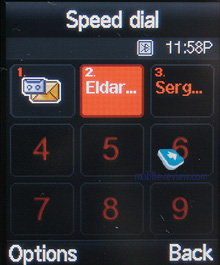
You can create any number of caller groups, assign up to 20 contacts and customize them with a picture and tune.
On an incoming call, caller ID picture occupies not the entire screen, but only a part of it.
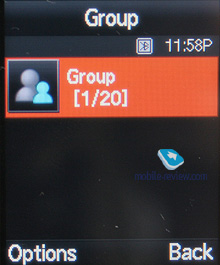
Back to the table of contents >>>
Call log
Each of the given lists contains up to 30 phone numbers. There is a combined list of all the last calls with an icon indicating call type. Pressing the navi-pad horizontally, you can switch quickly between the lists. The date and time of the calls are displayed in the extended view for separate entries. Calls from/to one number are grouped up, so that the number standing next to the call specifies total number of calls made. In order to access duration data you will need to call up detailed information on desired item. As always, the overall time of the calls and their cost can be viewed in this menu (in the case that the service has been enabled).
For individual numbers you can arrange a black list, which will reject all calls coming from these contacts.
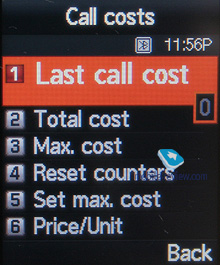
Back to the table of contents >>>
Messaging
Unlike Samsung’s contemporary offerings, the L320 sticks to the old scheme with SMS and MMS messages divided into separate categories; what’s more, there is no mail client. The phone memory can hold up to as many as 500 messages; the handset supports EMS standard compatible with Nokia Smart Messaging. T9 text input comes in handy and is easy to use. While choosing recipient, you can either select a telephone number from your contacts or pick one from the call lists or groups. All messages are manageable, this means you are at liberty to move a certain number to your black list, in order to make sure all messages coming from that phone number will be deleted automatically; possibility for moving messages to any own folder is also at your disposal.
There are no size restrictions set on received messages, though an outgoing message’s size is limited to 295 KB. As for additional services available with the L320, message rejection and message retrieval type options are onboard. All messages are stored in general dynamic memory, the same goes for e-mails.
Also there is a useful function for sending SOS-messages – when activated, should you find yourself in an emergency, after pressing the volume key four times, the message «I am in emergency. Please help me» will be sent to contacts submitted earlier, all incoming calls from these numbers upon sending the emergency message will be picked up automatically. Recipients (not more than 5), as well as number of Repeats may be set up manually, while text of the SOS-message is not customizable.
Back to the table of contents >>>
Organizer
There can be up to 300 different events of three types (3x100) - meeting, task, anniversary. Day and time as well as end time of an event are indicated for each entry. Alert signal and its duration can be adjusted to your liking; repeatable events are available for setting up (repeat time is also manageable as well as the exceptions). The weekly and the monthly calendar views are very convenient with each type of the event having its own color.
Speaking of the organizer’s shortcomings, I cannot overlook the fact that when typing date and time for an event, the end time doesn’t change, which badly hurts its ease of use – other manufacturers make the due time shift automatically (by default any event takes one hour).
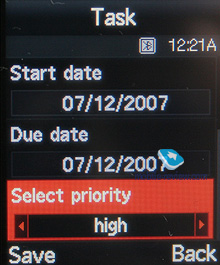
Back to the table of contents >>>
Applications
FM-radio. You can store up to 20 radio stations in the memory; the range of available frequencies is 87.5-108 MHz. Also, you can enjoy auto-tuning, but particular channels cannot have own names attached – they are always shown as the frequency numbers. The radio can work in handsfree mode, plus it enables you to set it up as an alarm clock, but regardless of how you are going to use it, a plugged-in headset is a must, since it doubles as an antenna. The radio implementation is fine, although it doesn’t pick up all stations equally well, but on balance, it is quite competent in comparison to other vendors’ offerings. The radio can be minimized.
RDS here displays only the station’s name in the general list, no advanced options available.
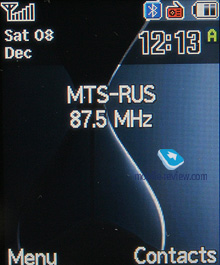
Voice recorder. You can record up to several hours of voice memos with the number of files being unlimited. Basically, limitations on recording duration are set by the user himself, though length of a single recording cannot exceed 1 hour. All the files are stored in a separate folder in the memory bank. The recorder performs well during lectures, conferences and presentations – I could even say that it is a partial substitute for a digital tape recorder.
World time is displayed for two chosen cities.
Calculator It divides, multiplies, subtracts and adds and does several more things – quite enough for a mobile calculator.
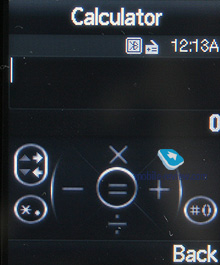
With the converter, you can operate with different units of measurements as well as with a number of currencies.
Countdown time and stopwatch have no bells and whistles.
Memo – standard text notes.
Java World. The handset comes pre-installed with 7 games, of which 3 are fully functional (Bobby Carrot, Airship Racing, Archangel), and four are demo-versions (limited by time or levels). These demos are quite fetching, these can be Tetris Mania, Midnight Pool, Minigolf, Poker and so on.
The memory volume assigned for Java-applications makes only 3.7 Mb, you can remove any of the pre-installed games at that, and upload new over the air (via WAP). Heap size can’t exceed 2 Mb, while the application can’t go over 1 Mb.
Google. A stand-alone menu item for accessing Google search and GMail. Generally, the same things are available with handsets from other manufacturers, except for a dedicated menu item.
Life style. This suite of applications for women comprises of 6 items – the first one on the list is Fragrance type, which picks fragrances based on your tastes and preferences. This could well be an interesting application, if only it provided specific recommendations for brands.
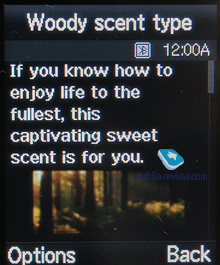
Biorhythm – you can opt for either the day or month view modes, as well as send your day’s data in an SMS.
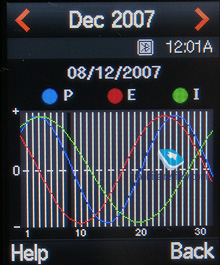
Height/weight ratio. This feature shows whether you have extra pounds or not based on your height.
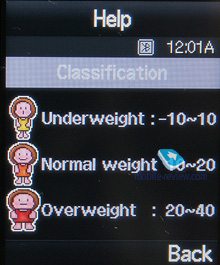
Calories – a calendar where you can take account of various types of your activities (from office working to making love), so the handset can automatically calculate how many calories you have burnt.
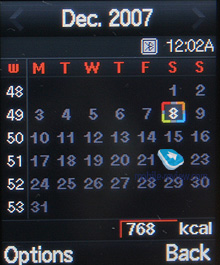
Pink schedule – self-explanatory calendar for periods.
Shopping list – you can compose shopping lists with items that have already been bought and those you are only planning to get. The L320 offers you five different shopping bags, which can include not only price and name of goods, but also their photos. Probably, some will actually put this feature to good use

Back to the table of contents >>>
WAP
The handset comes with a wap-browser version 2.0 (NetFront 3.4), where apart from JavaScript support, fonts scaling (three types), Smart-Fit (single-column view), full-screen mode (all controls are hidden), page caching, they have embedded a new feature – on-screen ‘mouse’ pointer. Much like Nokia’s S60-powered handsets and Opera Mini, you can view pages with a tiny navigation window displayed. The browser itself packs a lot of goods under the hood and will be appreciated by most users.
Back to the table of contents >>>
MP3-player
The integrated mp3 player, supporting random, sequential and cyclic playback, is available on the phone. Mp3 files can be uploaded onto the handset both directly over Bluetooth and through the synch application or Windows Media Player. There are no limitations placed on tags and names of music files. Bitrates are also not something that really matters – the handset easily deals with all available formats and supports WMA, AAC, eAAC, eAAC+.
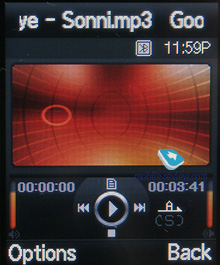
Your tracks can be played through the stereo headset as well as the speakerphone. The volume bar has 10 scales on it. And of course the user can make up their own playlists. Player can work in minimized mode.
The bundled headset doesn’t have a jack for plugging in own earphones, yet provides quite adequate sonic experience. However, compared to Samsung’s current device generation, the L320’s audio performance is pretty lackluster.
Alarm clock. The handset comes equipped with three alarm clocks. You can pick one of the five tunes, or turn to MP3 tracks for alarm tones. In settings it is possible to enable auto power-up of the phone when any event triggers.
File Manager (My files). That’s the place to search for all files such as music, pictures, video and sounds. Any uploaded file gets stored here. The disadvantage is that files sometimes are not displayed in the list immediately - in that case you will need to leave the menu and enter it again.
Files and folders can be viewed either as a list or thumbnails. You can mark any number of files. The handset supports Move, Copy and Delete operations, as well as various types of sorting (by type, name or size).
Memory card’s file structure is a slightly different story, as it can be accessed through the main menu, where each item features “Memory card” option.
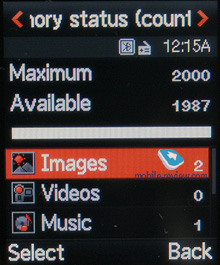
Back to the table of contents >>>
Settings. Traditionally this item boasts a standard set of options inside like password protection of selected sections (messages, short messages, organizer, etc.), backlighting duration and brightness, dialing display settings.
Keypad light – there are three options at your disposal, one of them is Night mode, implying that backlighting will be active only between 5:00 PM and 9:00 AM and disabled during daytime. If you come to think of it, this feature is nothing more but an illusive replacement for ambient light indicator, which Motorola’s handsets are armed with.
Mobile Tracker – submit a phone number, where notifications will be sent to in case SIM-card was changed – that message will contain number of the SIM-card being used with the handset. This section is protected with password, so that no one other than you or someone else who knows the password could disable the Tracker. Should your device have the SIM-card switched once, the specified number will receive one message instantly, and one more each time a new card is plugged in. A fetching feature which can prove to be of much help in case the handset is lost or stolen.

Apart from standard wallpapers for the standby mode, you can opt for a slideshow composed of the preinstalled pictures that will pop up in random order.
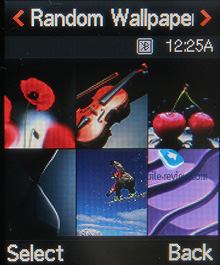
Back to the table of contents >>>
Impressions
The reception quality put up by the L320 is in line with other Samsung-branded devices. The ringtone volume is quite decent, as it can be heard in various environments. The silent alert is average strength-wise, no significant improvements have been made here.
Going for the L320 are its supreme battery time and a neat design. The cues it has taken from the Samsung E570 are not all that screaming, so it makes a nice change from bog-standard designs available for feminine phones. However, the L320 has quite a list of competitors employing similar concepts in design, these are the Motorola ROKR U9 and the Sony Ericsson Z750i (in a way). Both outdo the Samsung’s offspring in the feature department, yet go for pretty much the same money.
Samsung is banking on impulse-driven purchases, assuming that women who could go for the L320 are not savvy about functionality or technological talents of their phones like dated resolution, old player application and dated platform. The same approach was exercised with the original La’Fleur collection, where it worked out nicely, allowing those models to sell in substantial quantities. That’s why we are quite confident saying that the Samsung L320 will garner some following, although it doesn’t stand a good chance to close in on the Samsung E570’s numbers. Its price tag of 350-400 USD will put many off, since it doesn’t have the punch to take the owner’s breath away and that’s what the L320’s problem is.
This handset’s fate will also be affected by whether Samsung will launch the L420 (the third La’Fleur collection is already finished) or not, as it boasts a similar design, touch-sensitive player controls and updated software, the same as what comes inside other Samsung-branded solutions. All up, as soon as the L420 arrives, the Samsung L320 will kiss its career on the market goodbye. That’s how we come to an obvious conclusion that the L420 won’t debut or at all or will come out when it won’t pose any threat to today’s solutions, meaning that once again we will have another phone that will look already long in the tooth on its release day, compared to Samsung’s own products. Somewhat bizarre approach, but it looks like it has worked out for Samsung.
Back to the table of contents >>>
Eldar Murtazin (eldar@mobile-review.com)
Translated by Oleg Kononosov (oleg.kononosov@mobile-review.com)
Published — 27 March 2008
Have something to add?! Write us... eldar@mobile-review.com
|


































